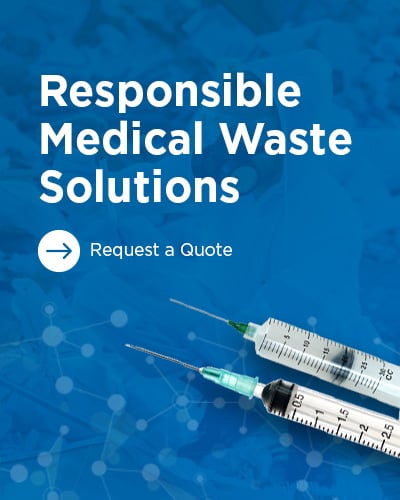
The American Hospital Association proposes that there are 951,045 staffed hospital beds in the United States every year. Therefore, according to Slate.com, it is estimated that it creates approximately 5.9 million tons of garbage annually—which could be even more since the hospitals surveyed already recycle or otherwise divert 10 percent of their waste. The World Health Organization estimates that there are more than 16 billion injections administered worldwide, and not all are disposed of properly afterward.
What is considered medical waste?
According to the Environmental Protection Agency, medical waste is a subset of waste generated at healthcare facilities, such as hospitals, physicians' offices, dental practices, blood banks, veterinary hospitals, clinics, medical research facilities, and laboratories. Typically, medical waste is healthcare waste that could be contaminated by elements such as blood, bodily fluids, or any other potentially infectious materials and is often referred to as regulated medical waste.
The Healthcare Environmental Resources Center states that although there is no universally accepted definition for medical waste, the explanations offered by most regulatory agencies are similar. Most federal and state agencies differentiate between common medical waste and those wastes with the potential to cause infection and for which special precautions are prudent. Depending on the state, these wastes are referred to as:
- Regulated medical waste
- Infectious waste
- Biomedical waste
Some state regulations use a general definition, while others list specific wastes and categories of waste considered infectious. Some states have adopted those found in federal standards.
States commonly regulate the following six medical wastes:
- Pathological waste. Tissues, organs, body parts, and body fluids are removed during surgery and autopsy.
- Human blood and blood products. Waste blood, serum, plasma, and blood products.
- Cultures and stocks of infectious agents (microbiological waste). Specimens from medical and pathology laboratories. Includes culture dishes and devices used to transfer, inoculate, and mix. Also includes discarded live and attenuated vaccines.
- Contaminated sharps. Contaminated hypodermic needles, syringes, scalpel blades, Pasteur pipettes, and broken glass.
- Isolation waste. It is generated by hospitalized patients isolated to protect others from communicable diseases.
- Contaminated animal carcasses, body parts, and bedding. From animals intentionally exposed to pathogens in research, biological production, or in vivo pharmaceuticals testing.
What percent of healthcare waste is medical waste?

The roadmap to sustainability organization estimates that healthcare waste is complicated due to its sheer volume, as well as because a large amount of that waste, about 15–20 percent, is regulated by multiple agencies, including EPA, OSHA, DOT, the Joint Commission, DEA, and others.
Medical waste disposal became a critical issue beginning in the 1980s. The east coast experienced a huge surge of medical syringes washing ashore in states like New Jersey, New York, and Connecticut between the years 1987-1989. It was nicknamed the “Syringe Tide,” which saw alarming amounts of garbage and medical waste, such as hypodermic syringes and blood, wash up on beaches along the East Coast. The pollution had prompted a record number of summer beach closings along the Jersey Shore and caused an estimated $1 billion in lost tourism revenue.
The Syringe Tide became so prevalent that it was even referenced in pop culture. Billy Joel alludes to it in his 1989 hit song, “we didn’t start the fire.” The 1988 song “Medical Waste” by Skinny Pup was also written in response to the ongoing problem. It is even referenced in television shows such as the Simpsons episode entitled “The Old Man and the C student” and the episode "The Gang Goes to the Jersey Shore" from the show It's Always Sunny In Philadelphia.
In 1988, in response to this crisis, the U.S. Congress passed the Ocean Dumping Ban Act, prohibiting all municipal sewage sludge and industrial waste dumping into the ocean after Dec. 31, 1991. This was Introduced in the Senate by then-Sen. Frank R. Lautenberg (D-N.J.) and, in the House, by then-Rep. William Hughes (D-2nd Dist.).The DEP convened a blue-ribbon panel of 16 experts to investigate coastal pollution problems in New Jersey and report recommendations. The state Legislature also produced a suite of bills in 1988 called the Clean Ocean Package, which included efforts to address stormwater runoff and sewage discharge and to establish a manifest system to track the disposal of medical waste.
In addition, the Medical Waste Tracking Act (MWTA) was a two-year federal program in which the EPA was required to promulgate regulations on the management of medical waste. The Medical Waste Tracking Act of 1988 was a United States federal law concerning the illegal dumping of body tissues, blood wastes, and other contaminated biological materials. It established heavy penalties for knowingly endangering life through non-compliance. The law expired in 1991.
Medical Waste continues to be regulated through the Environmental Protection Agency (EPA), the Federal Drug Administration (FDA), and Occupational Safety and Health Agency (OSHA). These agencies provide the base model for regulations for categorizing medical waste disposal. States can add to these standards, and they can be enforced through state and local authorities.
Medical Waste disposal continues to be a worldwide issue due to the potential for environmental harm and exposure to health risks to the world population that comes in contact with it. Therefore, it is critical to follow the rules and regulations by local and federal entities to mitigate the threats that medical waste poses.
Pureway Compliance PureWay is a leading provider of medical waste disposal, pharmaceutical waste disposal, hazardous waste, and OSHA Compliance for the healthcare industry.





